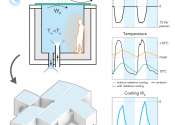Mexican start-up fights air pollution with artificial trees
Trees are one of the best things we have to clean the Earth's air, but they have certain drawbacks: they need time and space to grow.
Aug 15, 2019
1
694
Energy & Green Tech

Trees are one of the best things we have to clean the Earth's air, but they have certain drawbacks: they need time and space to grow.
Aug 15, 2019
1
694
Engineering

Mohammad Asadi, assistant professor of chemical engineering at Illinois Institute of Technology, has published a paper in the journal Science describing the chemistry behind his novel lithium-air battery design. The insights ...
Feb 2, 2023
1
659
Consumer & Gadgets

The multinational electronics company Xiaomi announced the development of a new power transmission system that can charge a cellphone from across a room without any wires or charging pads.
Automotive

Applying artificial intelligence to self-driving cars to smooth traffic, reduce fuel consumption, and improve air quality predictions may sound like the stuff of science fiction, but researchers at the Department of Energy's ...
Oct 29, 2018
0
168
Engineering

As the planet gets hotter, the need for cool living environments is becoming more urgent. But air conditioning is a major contributor to global warming since units use potent greenhouse gases and lots of energy.
Sep 25, 2023
0
49
Engineering

A team of engineers at the Luxembourg Institute of Science and Technology, working with a pair of colleagues from Murata Manufacturing Company, has developed a regenerative electrocaloric heat pump that is more efficient ...
Energy & Green Tech

The search for renewable energy sources, which include wind, solar, hydroelectric dams, geothermal, and biomass, has preoccupied scientists and policymakers alike, due to their enormous potential in the fight against climate ...
Jun 9, 2020
11
412
Energy & Green Tech

Metal-air batteries are one of the lightest and most compact types of batteries available, but they can have a major limitation: When not in use, they degrade quickly, as corrosion eats away at their metal electrodes. Now, ...
Nov 8, 2018
1
112
Energy & Green Tech

Zinc-air batteries (ZABs) are among the most promising next-generation battery technologies due to their many advantageous characteristics. Most notably, these batteries have unique half-open structures, a significant theoretical ...
Energy & Green Tech

The ingenuity of four space engineers has created a zero-emission air-conditioning system that doesn't pollute our atmosphere when we turn it on.
Jun 7, 2016
2
97
The Earth's atmosphere is a layer of gases surrounding the planet Earth that is retained by the Earth's gravity. It has a mass of about five quadrillion metric tons. Dry air contains roughly (by volume) 78.08% nitrogen, 20.95% oxygen, 0.93% argon, 0.038% carbon dioxide, and trace amounts of other gases. Air also contains a variable amount of water vapor, on average around 1%. The atmosphere protects life on Earth by absorbing ultraviolet solar radiation, warming the surface through heat retention (greenhouse effect), and reducing temperature extremes between day and night.
There is no definite boundary between the atmosphere and outer space. It slowly becomes thinner and fades into space. An altitude of 120 km (75 mi) marks the boundary where atmospheric effects become noticeable during atmospheric reentry. The Kármán line, at 100 km (62 mi), is also frequently regarded as the boundary between atmosphere and outer space. Three quarters of the atmosphere's mass is within 11 km (6.8 mi; 36,000 ft) of the surface.
This text uses material from Wikipedia, licensed under CC BY-SA